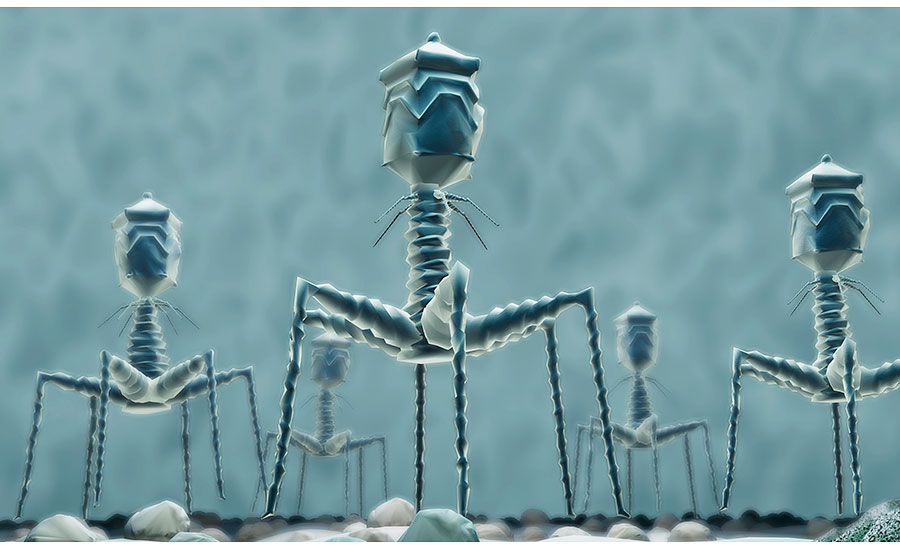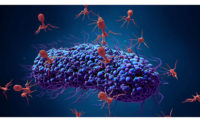Bacteriophages have been the next big thing for several years. Will this be the year phages break through for critical acceptance?
“From a research perspective, product applications and interest have certainly increased,” says Manan Sharma, Ph.D., research microbiologist at the Environmental Microbial & Food Safety Lab, U.S. Department of Agriculture, Agricultural Research Service, based in Beltsville, Md. “There could be more applications, public acceptance and improved methodology going forward.”
Bacteriophages naturally exist in the environment and have long been studied for their ability to infect and kill pathogens. They fell out of favor in the 20th century after antibiotics were discovered, but are regaining interest as a natural alternative to chemical antimicrobials and antibiotics.
“Very few companies have an approved product on the market,” says Tom Denes, Ph.D., assistant professor, University of Tennessee at Knoxville.
Researchers use different methodologies for phage application studies but the same language is used to describe the results, which makes the data hard to compare across studies, Denes says.
How it works
Phages are either imbedded in the product or applied to the surface of a product to kill pathogens, Denes says. According to Denes, post-harvest surface applications generally work better than imbedding.
Companies also see better results when they use higher concentrations of phages, he says.
“So, how much phage can be produced in a cost effective manner?” Denes asks.
Using a variety of phages produces a cocktail that is more effective against pathogens, Sharma says.
“The key is to figure out when to apply phages in the processing chain,” he says. “And it depends on the nature of the pathogens, as well.”
If processors apply a high number of phages to inoculate the product, they will get a quick reduction but not much effect after that, Sharma says.
“From looking at several papers, phages can reduce populations of pathogens, and combined with refrigeration temperatures of 4 degrees Celsius, will prevent E. coliand Salmonellaspp. from resuscitation in most cases,” he says.
What’s new
It’s hard to get market data on product use from the companies, but intervention options are limited, says Jason Gill, Ph.D., assistant professor of bacteriophage biology & microbiology in the Department of Animal Science at Texas A&M University, based in College Station, Texas.
An anti-O157:H7 phage product continues to be used as a pre-harvest intervention in cattle, he says.
“The product was recently spun off to [a company that is] continuing to market and develop the product,” Gill says. He adds that the product is reportedly used by several large beef processors, particularly in summer months when O157 prevalence is high. Development continues for phage products against the shiga-toxigenic E. coli (STEC), Salmonella and Campylobacter.
“Poultry is a big application but when, where and how to use phages in that system is still being worked on by the companies,” Gill says.
The poultry industry has generally been receptive to phages and some products are being used, he says.
“But the phage has to be both effective and economical for the industry to adopt it,” says Gill. “Some applications may work okay but require so much phage that it’s no longer economical. These issues are still being worked out for new applications.”
In some applications, phages are also competing with tools like lactic acid and peroxyacetic acid (PAA), which are very inexpensive.
“Salmonella in poultry has been a tough one partly because it’s a very diverse species, unlike E. coli O157 or Listeria monocytogenes, so getting good efficacy against all serovars [a distinct variation within a species of bacteria or virus] can be tough,” Gill says.
Poultry processors still need to figure out where to intervene in the pre- or post-harvest process: should the phage be fed to the live birds, sprayed on live birds before harvest, put in the chill water, etc.
“A big seven ETEC (E. coli) phage for beef has been in development for a while and hopefully will be on the market in a year or so,” Gill says.
What’s possible
An improved understanding of bacteriophages by the public will make it more likely that producers use them in the future, Denes says.
“People don’t understand that bacteriophages are abundant in the environment and in food,” he says.
To better select phages for applications, more research needs to be conducted on how phages interact with pathogens and how they attach themselves to bacteria, Denes says.
“I absolutely think phages have value, but the question is: What are the best ways to use them?” Denes says. “As more work is done, the products will improve. Phages evolve, so there are almost endless possibilities of their potential.”
Phage research is continuing on the same path and the rate of discovery is increasing, notes Sharma.
“More comprehensive studies are being conducted in a shorter amount of time,” says Sharma. “From a research perspective, we can focus on execution now, not on design. So the enzymes in phages, for example, can be further explored and exploited to target bacteria.” NP










